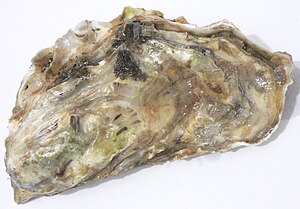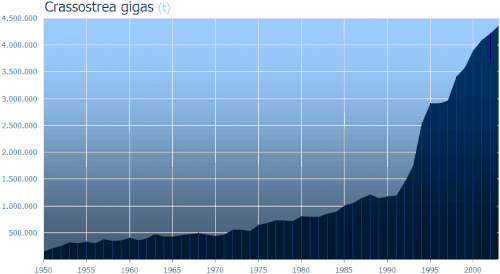Pacific oyster
| Pacific oyster | ||||||||||||
|---|---|---|---|---|---|---|---|---|---|---|---|---|

Pacific oyster ( Magallana gigas ) |
||||||||||||
| Systematics | ||||||||||||
|
||||||||||||
| Scientific name | ||||||||||||
| Magallana gigas | ||||||||||||
| ( Thunberg , 1793) |
The Pacific oyster ( Magallana gigas , Syn .: Crassostrea gigas ), also known as the Pacific rock oyster, is the commercially most important oyster species with a world market share of 93.7% (2003). Its name is Huître creuse (du Pacifique) in French and Pacific (cupped) oyster in English . This type of oyster is extremely robust and disease resistant, and it grows very quickly.
features
The unevenly hinged housing is 8 to 30 cm long, in rare exceptional cases even up to 40 cm long. The right "upper" flap is flat with a low, round vortex . The left, "lower" flap is larger and strongly arched. It has a well-developed vertebra that is much higher than that of the right valve. The outline is highly variable, mostly depending on the ground. On hard grounds it is usually rounded, on softer ground it is often oval-elongated and in small oyster reefs it is often with irregular edges. The lock has no teeth. The ligament lies externally on either side of the vertebra. The resilium is completely fibrous and connects both valves with lamellar layers. There is only a single, quite large, pink or violet-colored sphincter muscle. There is an additional muscle dorsally (Quenstedt muscle).
The calcitic shell is very thick, very hard and heavy. The edge of the case has a sharp edge and is not notched on the inside. The surface has concentric and very irregular lamellas. The color is usually whitish, gray, occasionally also brownish or greenish.
Geographical distribution
This oyster species originally comes from the coastal waters of the western Pacific from Sakhalin (approx. 48 ° N) in the north to Kyushu (Japan) in the south, on the mainland coast to southern China (approx. 30 ° N). However, it has now been spread over large parts of the world as a farmed oyster. According to genetic analyzes, the breeding animals came from the coast of Miyagi Prefecture in the northeast of the Japanese main island of Honshu . It has spread further from the oyster cultures in Europe. In 1964 the species was released in the Oosterschelde (Netherlands), from where it then spread to the northwest and reached the Wadden Sea near Texel around 1980 . In the area of the German North Sea coast it was first discovered in 1986 near the first German oyster farm west of Norddeich . Until 2002 there were only a few Pacific oysters in the Lower Saxony Wadden Sea. It is now feared that the neozoon, due to the lack of predators and milder winters , could displace the mussels as the predominant mussels. It was also settled in the Mediterranean. There, too, it has spread from the oyster farms.
In the North Sea, the Pacific oyster does not replace the European oyster ( Ostrea edulis ), which was exterminated by overfishing until 1930 , as this species only formed oyster beds in the shallow sublittoral .
Habitat and way of life
The Pacific oyster lives in coastal waters at depths of 4 to 50 meters. It prefers rocky subsoil, but also accepts muddy or sandy soil with shell fragments or live or dead mussels on which the larvae can settle. They are usually cemented to hard ground with the left valve. They are filter feeders that filter plankton out of the water.
With a size of 50 mm and an age of one year, they are already sexually mature. The animals are initially males, only after a year do they change their sex or not. After that they are males or females, they no longer change their sex (as with other oyster species), so they are sexually separated. However, the gender ratio is often disproportionate, with more males or more females. They spawn in July and August when the water temperature is between 17 and 28 ° C. The best temperature is between 19 and 23 ° C. The salinity must be between 23 and 28 ‰. A salinity of around 18 ‰ results in a 98% lethality. The sex products are released into the open water. The females produce 50 to 100 million eggs per spawning process. However, a female can spawn several times under certain circumstances. After fertilization in the open water, the eggs first develop into trochophora larvae, which quickly develop into Veliger larvae. The Veliger larvae drift in the plankton for three to four weeks before they migrate to life on the ground as pediveligers and metamorphose . The life expectancy of the Pacific oyster in natural conditions is estimated to be 20 to 30 years.
Aquaculture
The Pacific oyster is seldom fished in its original range, but is mainly farmed in aquaculture . The world's largest producer is China with 3.7 million tons per year, that is 83.3% of world production. Japan and North Korea (both 5.9%) and France (2.6%, which in 1995 corresponded to 96.7% of European production) follow at a considerable distance . In aquaculture, the Pacific oysters are affected by a virus, the Ostreiden herpesvirus 1 , especially in the larval stage , which can lead to considerable losses and is of great economic importance in oyster farming. The virus cannot infect other animals. The lethality in adult oysters is up to 30%, in juvenile oysters up to 100%. The outbreak of the infectious disease is temperature dependent. The virus becomes active from a water temperature of around 16 ° C.
The Pacific oyster as a seafood
In Asia, the Pacific oysters are usually used as " meat oysters", i.e. eaten in a prepared form. They also serve as a starting product for derivatives such as B. Oyster Sauce . In Europe they are almost exclusively consumed raw ("slurped"). They are usually offered as "fines de claires", occasionally also according to their origin. Well-known provenances are “ Cancale ” and “Marennes-Oléron” ( France ), as well as “ Sylter Royal ” ( Germany ), “Loch Fyne” ( Scotland ) and “Willapa” ( United States ).
- World annual production in tons
Taxonomy
The taxon was described by Carl Peter Thunberg in 1793 as Ostrea gigas . Today it is assigned to the genus Magallana , the genus was only established in 2016 by Salvi & Mariottini based primarily on molecular biological data.
supporting documents
literature
- Maren Peters: Aliens in the Wadden Sea. The North Sea is conquered by exotic species. The Pacific oyster could even replace the native mussel. (In: FOCUS, No. 11/2007, p. 150/151)
- Max Rauner: Pacific oyster - SHOWDOWN in the Anthropocene . In: TIME .
- Argyro Zenetos, Serge Gofas, Giovanni Russo, José Templado: CIESM Atlas of Exotic Species in the Mediterranean. Vol.3 Mollusca. CIESM (Frédéric Briand, ed.), Monaco, 2003 ISBN 92-990003-3-6 (p. 234/235, text online )
Individual evidence
- ^ A b Carl Peter Thunberg: Tekning och Beskrifning på en stor Ostronsort in Japan. Konglika Vetenskaps Academies Nya Handlingar, ser. 2, 14: 140-142, Stockholm, 1793 Online at www.biodiversitylibrary.org
- ^ Karin Troost: Causes and effects of a highly successful marine invasion: Case study of the introduced Pacific oyster Crassostrea gigas in continental NW European estuaries. Journal of Sea Research, 64: 145-165, 2010 doi : 10.1016 / j.seares.2010.02.004
- ↑ Delphine Lallias, Pierre Boudry, Frederico M. Batista, Andy Beaumont, Jonathan W. King, John R. Turner, Sylvie Lapègue: Invasion genetics of the Pacific oyster Crassostrea gigas in the British Isles inferred from microsatellite and mitochondrial markers. Biological Invasions, 17 (9): 2581-2595, 2015 doi : 10.1007 / s10530-015-0896-1
- ^ S. Diederich, G. Nehls, JEE van Beusekom, K. Travel: Introduced Pacific oysters (Crassostrea gigas) in the northern Wadden Sea: invasion accelerated by warm summers? Helgoland Marine Research, 59: 97-106, 2004 doi : 10.1007 / s10152-004-0195-1
- ↑ a b Department of Seas and Coasts of WWF Germany : The immigration of the Pacific oyster into the Lower Saxony Wadden Sea. (PDF) January 2, 2006, accessed April 29, 2016 .
- ↑ a b John McCabe: The Reproduction and Growth of the Pacific Oyster (2004)
- ↑ a b The fish site: Oyster Herpes Virus (OsHV-1) ( Memento of the original from August 27, 2016 in the Internet Archive ) Info: The archive link was inserted automatically and has not yet been checked. Please check the original and archive link according to the instructions and then remove this notice.
- ↑ information of FAO (Engl.)
- ↑ MolluscaBase: Magallana gigas (Thunberg, 1793)
- Jump up ↑ Daniele Salvi, Paolo Mariottini: Molecular taxonomy in 2D: a novel ITS2 rRNA sequence-structure approach guides the description of the oysters' subfamily Saccostreinae and the genus Magallana (Bivalvia: Ostreidae). Zoological Journal of the Linnean Society, 179 (2): 263-276, 2016 doi : 10.1111 / zoj.12455

